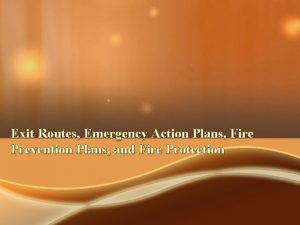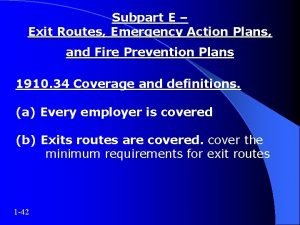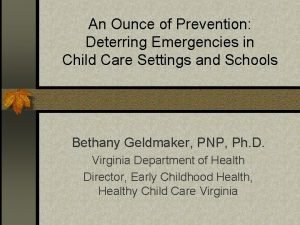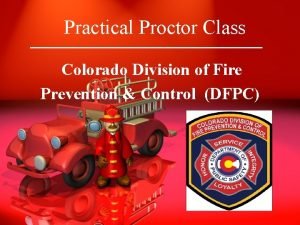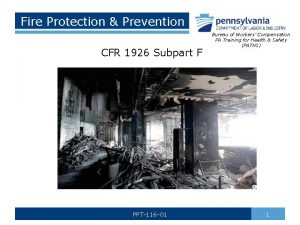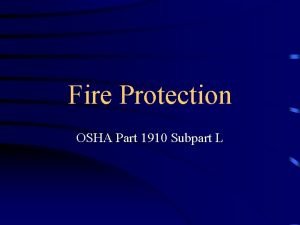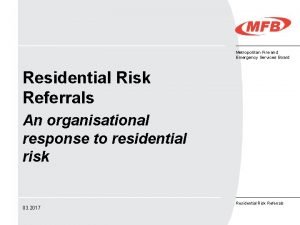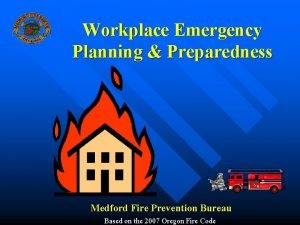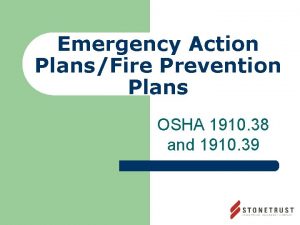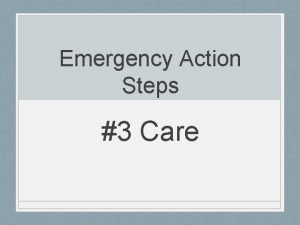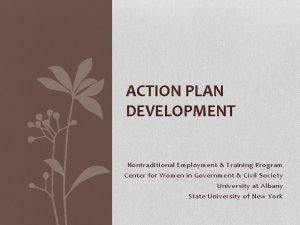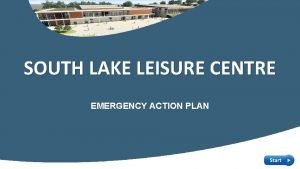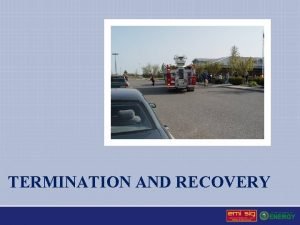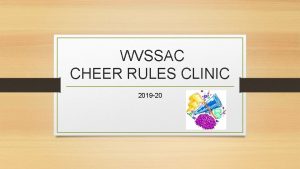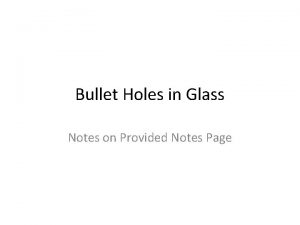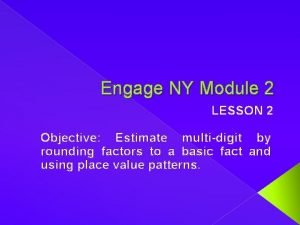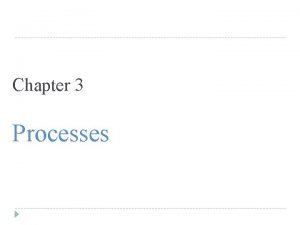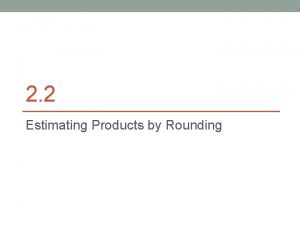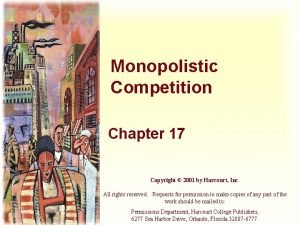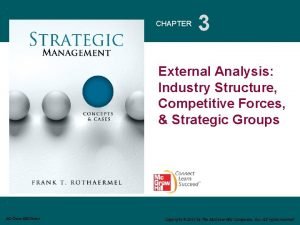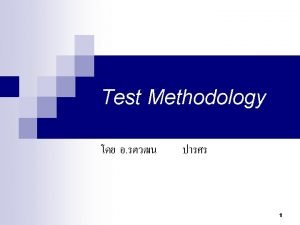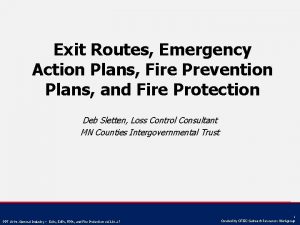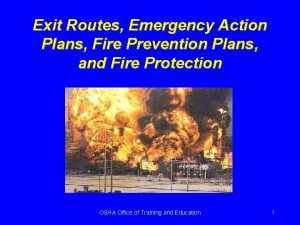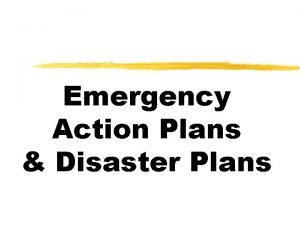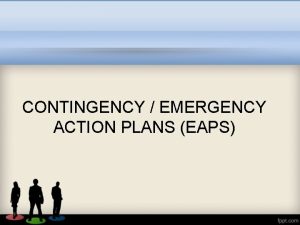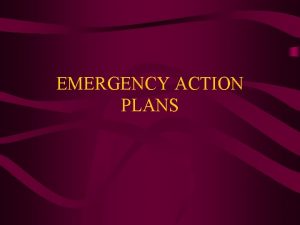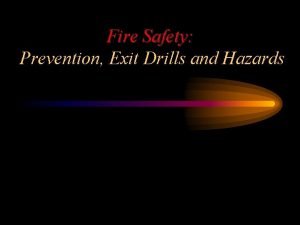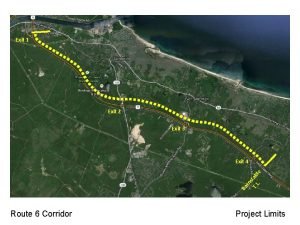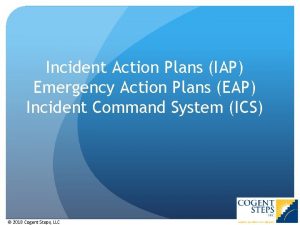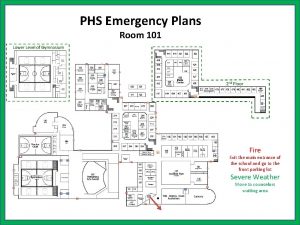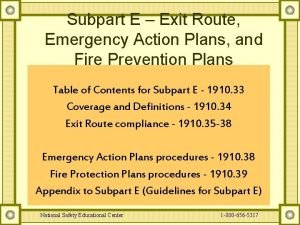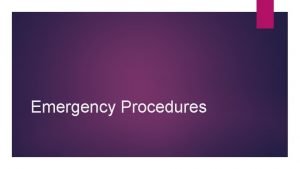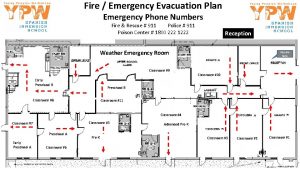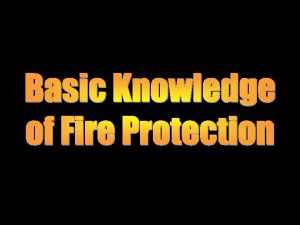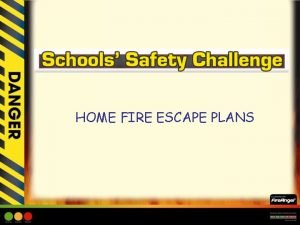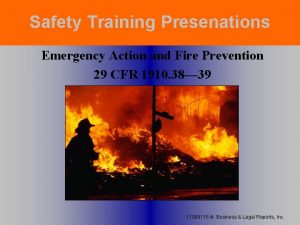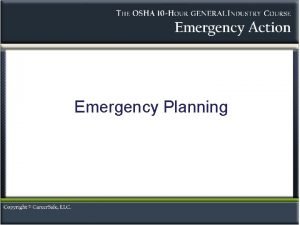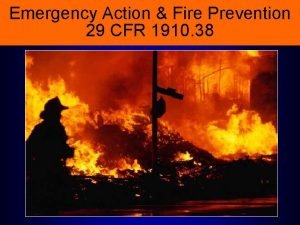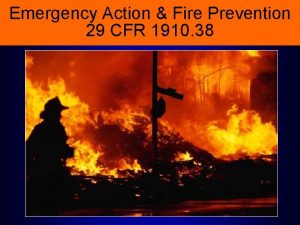Exit Routes Emergency Action Plans and Fire Prevention







































- Slides: 39

Exit Routes, Emergency Action Plans, and Fire Prevention Plans l 1910 Subpart E Presented by: ETTA, OSH Division, 919 -807 -2875 This presentation was created by the N. C. Department of Labor for safety and health training.

Objectives 1910 Subpart E In this course, we will discuss the following: l Exit routes (means of egress) l Coverage and definitions l Design requirements l Operational features l Emergency action plan l Fire prevention plan l National Fire Protection Association (NFPA) 101 This presentation was created by the N. C. Department of Labor for safety and health training.

Means of Egress 1910. 34(a)–(b) l Every employer is covered l Exit routes are covered - Minimum requirements for exit routes to allow for the safe evacuation of employees during an emergency - Also covers the minimum requirements for emergency action plans and fire prevention plans. This presentation was created by the N. C. Department of Labor for safety and health training.

Means of Egress 1910. 34 NCDOL Photo Library This presentation was created by the N. C. Department of Labor for safety and health training.

Definitions l Egress NFPA 3. 3. 172 NCDOL Photo Library - Act or an instance of going from an enclosed place - A means or place of going out; an exit - Right or permission to go This presentation was created by the N. C. Department of Labor for safety and health training.

Definitions 1910. 34(c) l Exit route - A continuous and unobstructed path of exit travel from any point within a workplace to a place of safety (including refuge areas) This presentation was created by the N. C. Department of Labor for safety and health training.

Definitions 1910. 34(c) l Exit access - That portion of a means of egress that leads to an exit This presentation was created by the N. C. Department of Labor for safety and health training.

Definitions 1910. 34(c) l Exit - That portion of an exit route that is generally separated from other areas to provide a protected way of travel to the exit discharge This presentation was created by the N. C. Department of Labor for safety and health training.

Definitions 1910. 34(c) l Exit discharge - Part of the exit route that leads directly outside or to a street, walkway, refuge area, public way, or open space with access to the outside This presentation was created by the N. C. Department of Labor for safety and health training.

Design Basic Requirements 1910. 36(a)(1)–(3) l Exit routes must be: - Permanent - Separated by fire resistant materials - Openings into an exit must be limited This presentation was created by the N. C. Department of Labor for safety and health training.

Exit Routes 1910. 36(b) l The number of exit routes must be adequate. - Two exit routes - More than two exit routes - A single exit route This presentation was created by the N. C. Department of Labor for safety and health training.

Exit Discharge 1910. 36(c)(1)–(3) l Each exit discharge must lead directly outside or to a street, walkway, refuge area, public way, or open space with access to the outside l The street, walkway, refuge area, public way, or open space to which an exit discharge leads must be large enough to accommodate the building occupants likely to use the exit route l Exit stairs that continue beyond the level… clearly indicate the direction of travel…” This presentation was created by the N. C. Department of Labor for safety and health training.

Exit Discharge 1910. 36(c)(1) Exit Door This presentation was created by the N. C. Department of Labor for safety and health training.

Exit Route Design 1910. 36(d)–(h) l Must be: - Unlocked and unrestricted - Side-hinged - Adequate capacity and height - Must meet height and width requirements - Outdoor exit route permitted This presentation was created by the N. C. Department of Labor for safety and health training.

Unlocked and Unrestricted 1910. 36(d) l Must be able to open door from inside without keys, tools, or special knowledge - Panic bars that lock from the outside are permitted l Must be free of device or alarm that could restrict emergency use if device or alarm fails l May be locked from inside in mental, penal, or correctional facilities - And only if supervisory personnel are continuously on duty and there is an emergency plan This presentation was created by the N. C. Department of Labor for safety and health training.

Side-Hinged 1910. 36(e) l Must be used to connect any room to an exit route l Door that connects any room to an exit route must swing out in direction of exit travel if room is designed to be occupied by more than 50 people or if room is a high hazard area This presentation was created by the N. C. Department of Labor for safety and health training.

Adequate Capacity 1910. 36(f) l Must support maximum permitted occupant load for each floor served l Capacity of exit route may not decrease in direction of exit route travel to exit discharge - Note: Information regarding “occupant load” is located in NFPA 101 -2009, Life Safety Code and in IFC-2009, International Fire Code. NCDOL Photo Library This presentation was created by the N. C. Department of Labor for safety and health training.

Minimum Height and Width 1910. 36(g) l Ceiling of exit route must be at least seven feet six inches high l Exit access must be at least 28 inches wide at all points l Width must accommodate maximum permitted occupant load of each floor l Objects that project into exit route must not reduce width of exit route to less than minimum width requirements This presentation was created by the N. C. Department of Labor for safety and health training.

Outdoor Exit Route 1910. 36(h) l Have guardrails to protect unenclosed sides if a fall hazard exists l Covered if snow or ice is likely to accumulate along route l Reasonably straight and have smooth, solid, substantially level walkways l Must not have a dead-end that is longer than 20 feet This presentation was created by the N. C. Department of Labor for safety and health training.

Exit Route Maintenance and Safeguards 1910. 37(a)–(e) l Danger to employees minimized l Adequate and appropriate lighting and marking l Fire retardant properties maintained l Exit routes maintained during construction and repairs l Employee alarm system must be operable This presentation was created by the N. C. Department of Labor for safety and health training.

Danger to Employees Minimized 1910. 37(a) l Kept free of explosive or highly flammable furnishings or other decorations l Arranged so employees will not travel toward a high hazard area l Must be free and unobstructed l Safeguards designed to protect employees during an emergency must be in proper working order at all times This presentation was created by the N. C. Department of Labor for safety and health training.

Lighting and Marking 1910. 37(b)(1)-(4) l Adequately lighted l Clearly visible and marked by a sign reading “Exit” l Free of decorations or signs that obscure visibility of exit l If direction of travel to exit is not apparent, signs must be posted along exit access indicating direction of travel to nearest exit This presentation was created by the N. C. Department of Labor for safety and health training.

Lighting and Marking 1910. 37(b)(5) l Each doorway or passage along exit access that could be mistaken for an exit must be marked “Not an Exit” or be identified by a sign indicating its actual use This presentation was created by the N. C. Department of Labor for safety and health training.

Lighting and Marking 1910. 37(b)(6)-(7) l Each exit sign must be illuminated by a reliable light source and be a distinct color l Must have the word “Exit” in plainly legible letters not less than six inches high, with the principal strokes of the letters in the word “Exit” not less than three-fourths of an inch wide This presentation was created by the N. C. Department of Labor for safety and health training.

Fire Retardant Properties 1910. 37(c) l Fire retardant paints or solutions must be renewed as often as necessary to maintain their fire retardant properties This presentation was created by the N. C. Department of Labor for safety and health training.

Construction and Repairs 1910. 37(d) l During new construction, employees must not occupy a workplace until exit routes are completed and ready for employee use l During repairs or alterations, employees must not occupy a workplace unless exit routes are available and existing fire protections are maintained, or until alternate fire protection is furnished l Employees must not be exposed to hazards of flammable or explosive substances or equipment used during construction, repairs, or alterations This presentation was created by the N. C. Department of Labor for safety and health training.

Operable Alarm System 1910. 37(e) l Install and maintain an operable employee alarm system that has a distinctive signal to warn employees of fire or other emergencies, unless employees can promptly see or smell a fire or other hazard in time to provide adequate warning to them l Employee alarm system must comply with § 1910. 165 This presentation was created by the N. C. Department of Labor for safety and health training.

Psychological Hazards l Lack of information l Panic l Confusion This presentation was created by the N. C. Department of Labor for safety and health training.

Physical Hazards l Fire l Toxic vapors l Threats l Storms l Other This presentation was created by the N. C. Department of Labor for safety and health training.

Emergency Action Plan 1910. 38(a)–(b) l An employer must have an emergency action plan whenever an OSHA standard in this part requires one l An emergency action plan (EAP) NCDOL Photo Library must be in writing kept at the workplace and available to employees when required l If an employer has 10 or fewer employees, it may be communicated verbally This presentation was created by the N. C. Department of Labor for safety and health training.

EAP Elements 1910. 38(c) l Must have procedures for: » Reporting a fire or other emergency » Emergency evacuation » Employees who operate critical operations » Account for employee post evacuation » Employees performing rescue or medical duties » Name or job title of every employee who may be contacted about the EAP This presentation was created by the N. C. Department of Labor for safety and health training.

Alarm System and Training 1910. 38(d)–(f) l Maintained and distinctive sounds based on an emergency l Employer must designate and train employees for a safe and orderly evacuation l Employer must review EAP with employees: - Development and/or initial hiring - Job change - Plan change This presentation was created by the N. C. Department of Labor for safety and health training.

Fire Prevention Plan 1910. 39(a)–(b) l An employer must have a fire prevention plan when an OSHA standard in this part requires one l A fire prevention plan must be in writing, kept at the workplace, and available to employees for review l If an employer has 10 or fewer employees, it may be communicated verbally NCDOL Photo Library This presentation was created by the N. C. Department of Labor for safety and health training.

Fire Plan Elements 1910. 39(c) l Must have procedures for: - A list of all major fire hazards, proper handling and storage - Accumulation controls for flammable and combustible waste materials - Procedures for regular maintenance - Name or job title of employees responsible maintaining equipment - Name or job title of employees responsible for control of fuel source This presentation was created by the N. C. Department of Labor for safety and health training.

Employee Information 1910. 39(d) l An employer must inform employees upon initial assignment to a job of the fire hazards to which they are exposed l An employer must also review with each employee those parts of the fire prevention plan necessary for self-protection This presentation was created by the N. C. Department of Labor for safety and health training.

Exit Routes, Emergency Action Plans, and 1910 Subpart E Appendix Fire Prevention Plans l Non-mandatory guideline to assist employers in complying with the appropriate requirements 1. Emergency action plan elements 2. Emergency evacuation 3. Emergency action plan training 4. Fire prevention housekeeping 5. Maintenance of equipment under fire prevention plan This presentation was created by the N. C. Department of Labor for safety and health training.

Alternate Exit-Route Codes 1910. 35 l If an employer complies with the exit-route provisions of: – NFPA 101, Life Safety Code, 2009 or – International Fire Code, 2009 …. then OSHA will deem in compliance with the OSHA standards This presentation was created by the N. C. Department of Labor for safety and health training.

Summary 1910 Subpart E l Exit routes (means of egress) l Coverage and definitions l Design requirements l Operational features l Emergency action plan l Fire prevention plan l NFPA 101 This presentation was created by the N. C. Department of Labor for safety and health training.

Thank You For Attending! Final Questions? This presentation was created by the N. C. Department of Labor for safety and health training.
 1/3 diagonal rule egress
1/3 diagonal rule egress Exit exit access and exit discharge
Exit exit access and exit discharge Primary prevention secondary prevention tertiary prevention
Primary prevention secondary prevention tertiary prevention 1910 subpart e
1910 subpart e Fire hose reel signage standards
Fire hose reel signage standards An ounce of prevention emergency
An ounce of prevention emergency Dfpc jprs
Dfpc jprs Ppt116
Ppt116 1910 fire extinguisher
1910 fire extinguisher Metropolitan fire and emergency services board
Metropolitan fire and emergency services board Medford fire prevention
Medford fire prevention Fire prevention plan osha
Fire prevention plan osha San francisco fire prevention
San francisco fire prevention List the emergency action steps
List the emergency action steps Examples of goals, objectives and action plans
Examples of goals, objectives and action plans Emergency action step
Emergency action step Emergency action plan swimming pool
Emergency action plan swimming pool Drowning emergency action plan
Drowning emergency action plan Emergency action termination
Emergency action termination Wvssac emergency action plan
Wvssac emergency action plan What are the emergency action steps
What are the emergency action steps Reichstag fire who was the fire starter
Reichstag fire who was the fire starter Canvas connection hvac
Canvas connection hvac A-e rwi
A-e rwi Race fire safety
Race fire safety Central.route persuasion
Central.route persuasion Cognitively based attitude
Cognitively based attitude Module 5 intersections and roundabouts
Module 5 intersections and roundabouts Sequence of bullet holes in glass
Sequence of bullet holes in glass Round the factors and estimate the products
Round the factors and estimate the products Fork() wait() exec() and exit() system calls
Fork() wait() exec() and exit() system calls Round the factors and estimate the products 656 x 106
Round the factors and estimate the products 656 x 106 Excess capacity on a graph
Excess capacity on a graph Chapter 7 section 1 perfect competition worksheet answers
Chapter 7 section 1 perfect competition worksheet answers Free entry and exit
Free entry and exit Monopolists oligopolists may be artists
Monopolists oligopolists may be artists Free entry and exit
Free entry and exit Free entry and exit
Free entry and exit Responsibility process
Responsibility process Vikings routes travelled
Vikings routes travelled

